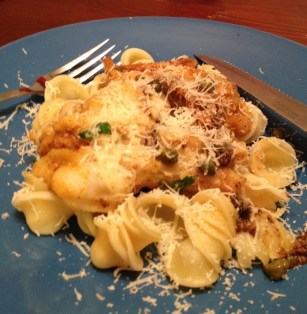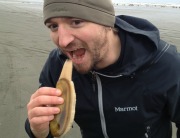
Before the overdose: Ted can hardly wait to nosh a razor clam. (Photo by Elisabeth Kwak-Hefferan.)
If you’ve never enjoyed a fresh bivalve harvest, here’s a tip: 15 razor clams is a significant gustatory investment. Hey, I love clams. I love them swimming in chowder, peeking out of my linguine, breaded and fried. But trust me, after spending an hour knuckle-deep in clam innards, I know now that even the most ardent enthusiast would do well to pace herself.
Soon after a wildly successful first clam dig on Washington’s Roosevelt Beach, I found myself back in my kitchen, staring into a bucketful of razor clams. Fifteen meaty clams needed killing, de-shelling, dressing, and cooking before we could enjoy the sautéed clam recipe we’d been talking about for the past 100 miles. It was already past 8 p.m.; perhaps we’d been a bit ambitious.
There was the matter of killing them, for one. None of the pieces of clam literature I’d studied mentioned exactly what you’re supposed to do between shoreline and skillet. On the advice of a veteran clammer, we’d kept our catch alive in seawater on the three-hour journey home for maximum freshness.
“Everything I’ve read just starts with ‘Pour boiling water over them for a few seconds until the shell pops open,'” I told my boyfriend and co-chef, Ted. “Can that be right?” With the clams still squirming around in the bucket, I suddenly felt a little seasick.
Ted gave me a look. “You’re going to make me do this, aren’t you?”
I’m not a vegetarian, so in theory I should be fine with the fact that my dinner once squirmed about in the sand, growing and reproducing and generally minding its own business until I came along. And my conscience could be clear: The clams I’d just harvested myself with a PVC-pipe “gun” beat the pants off of factory-farmed protein in terms of sustainability. But that didn’t make me feel any better about their imminent doom in our kitchen sink.
I retreated to a spot by the fridge while Ted boiled a pot of water and arranged the first batch of razor clams in our colander. While I offered support (“Just get it over with!”), he poured the water over our catch for a few seconds (any longer and you risk rubberizing your dinner). The shells popped open, each revealing a glistening, plump, meaty clam that slid easily out of its armor and into a bowl, ready to be cleaned. Well, usually: Three or four clams somehow survived their first bath, forcing Ted to douse them again and earning themselves a spot in my nightmares for weeks to come.

Gutted: The clams are ready for frying! (Photo by Elisabeth Kwak-Hefferan.)
I may have demurred when it came to sending our shellfish to the Great Tidal Flats in the Sky, but I bucked up for snipping out their nasty bits. Cleaning razor clams is a straightforward business: Slice ’em open, cut out the dark stuff. Ted and I took turns trimming away their gills and vivisecting their digestive systems under a thin stream of running water. Fun fact: The small, flexible rod found in a clam’s stomach is a harmless enzyme used for digestion, not a predatory worm that should make you shriek and drop the clam when you feel it on your palm — although that would be a perfectly rational reaction.
Experts can clean a clam in less than a minute, but we progressed more slowly, and it was 10 p.m. before our stack was ready for the sauté pan. Happily, the prepped clams now looked more like giant, innocuous pieces of ravioli than mollusks. We enthusiastically dredged them in seasoned flour, cooked them in butter and oil, then doused them with white wine and garlic.
The first sample bites had our eyes rolling back in sensory delight: juicy, meaty, with bursts of sharp flavor from capers and parsley. This could be the finest meal we’d ever created.
But we couldn’t sit down and savor them just yet — a stack of raw clams waited by the stove. Into the pan they went, two or three at a time, to sizzle and crisp while we hovered, salivating. Ted cut more than a few samples from the finished filets to tide us over. It was past 11 by the time we actually sat down to our choicest cuts over pasta.
“Isn’t this amazing?” we asked each other between bites. But as we shoveled forkful after forkful into our mouths, I began to notice something. Gaping shells still littered the counter. Clam necks piled up in the sink. A faintly fishy odor had our cat sniffing around the stove. And the sensation of manhandling the internal organs of 15 clams lingered, disturbingly fresh, in my head.

Ready to eat! (Photo by Elisabeth Kwak-Hefferan.)
Bellies a little too full, we cleaned the kitchen and packed up the leftovers. “There’s enough here for at least three more meals,” I said. “Maybe tomorrow night?” “Yeah, sure,” said Ted. But the thought of even one more bite of clam made my stomach lurch. Ted’s face told me he was in the same boat.
We tried to feast on the clams for lunch the next day, we really did. I just couldn’t quite do it. Perhaps a new preparation was in order — something a little less clammy? That night, we cooked up a big pot of chowder and tossed in the sautéed leftovers. Then we promptly decided to freeze it all for later and have a sandwich instead.
Now, a few weeks later, the thought of clams once again sounds appetizing. We’ll be warming up the chowder and toasting our good fortune soon enough. And we’re already talking about the next spring clam dig. Only this time, we’ll have a chowder party and cook up the fresh-caught clams for a crowd.
You’d better come prepared to eat, ‘cause I’m not tolerating any leftovers.
Italian Razor Clams
adapted from Michael Lalewicz’s recipe in the Seattle Times
1 cup all-purpose flour
1 teaspoon sea salt
1/4 teaspoon cayenne pepper
1 teaspoon paprika
1 tablespoon butter
2 tablespoons olive oil
4 medium-to-large cleaned, fresh razor clams
1 tablespoon chopped garlic
1 tablespoon capers
Juice of 1/2 lemon
3 tablespoons dry white wine
Salt and pepper
2 tablespoons fresh, chopped parsley
Pasta of choice, cooked and drained
Combine flour, sea salt, cayenne pepper, and paprika in a shallow bowl. Heat olive oil and one tablespoon butter in a sauté pan on medium heat. Dredge clams in flour mixture, then cook two minutes. Turn and cook until golden brown, another two minutes.
Add garlic, capers, lemon juice, wine, parsley, and a dash of salt and pepper. Cook on high until liquid is reduced; remove from heat. Serve on top of pasta. Serves two.
Pacific Clam Chowder
adapted from Bon Appetit
3 8-ounce bottles clam juice
1 pound russet potatoes, cut into 1/2-inch pieces
2 tablespoons butter
3 slices bacon, finely chopped
2 cups chopped onions
1 1/4 cups chopped celery with leaves
2 garlic cloves, chopped
1 bay leaf
1/4 cup all-purpose flour
8-10 razor clams, cleaned and chopped
1 1/4 cups half-and-half
1 teaspoon hot pepper sauce
Salt and pepper
Bring clam juice and potatoes to a boil in a heavy saucepan over high heat. Reduce heat to medium-low; cover and simmer until potatoes are tender, about 10 minutes. Remove from heat.
Melt butter in large pot over medium heat. Add bacon and cook until it begins to brown, about eight minutes. Add onions, celery, garlic, and bay leaf and sauté until vegetables soften, about six minutes. Stir in flour and cook two minutes (don’t let it brown). Add potato mixture, clams, half-and-half, and hot pepper sauce. Simmer five minutes, stirring frequently. Season to taste with salt and pepper. Serves four.




